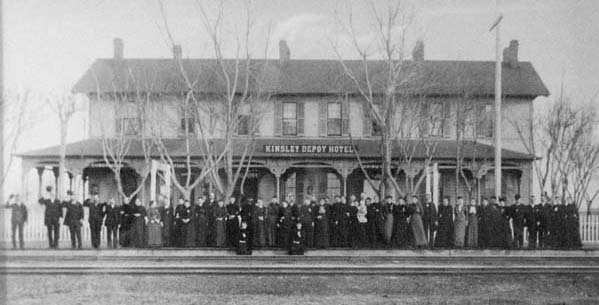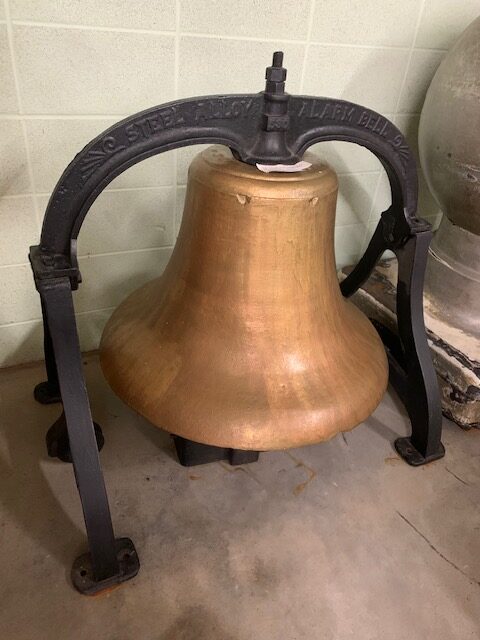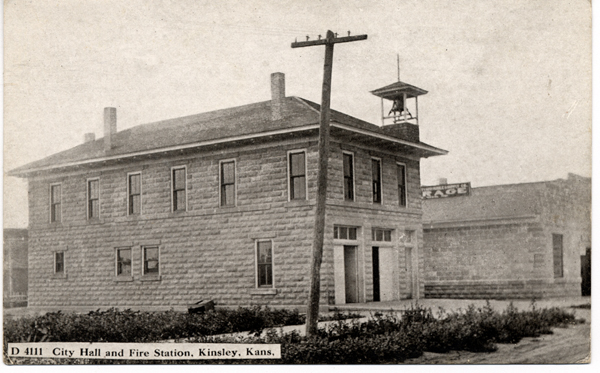When the city purchased the two hose carts in 1888, they stored them in a 2-story frame building on the west side of Marsh Ave. In 1889 the second floor was fitted out as a meeting room for the volunteers, but because the building was in the railroad right of way, it was moved two lots to the south.
However, the city did not own this lot, so in July 1896, the hose house was again moved, this time to the east side of Marsh Ave where the Alcorn livery barn had burned down eight years earlier. The 1899 Sanborn insurance map labels it as both the city hall and hose house. The bell tower was moved to its south side and the “lock up” located behind it.
No major fire had occurred in Kinsley ever since the Carlin House and the livery barn fires eight years earlier. But that good fortune ended on July 22, 1896, when a fire started in the bakery of the Kinsley Depot Hotel. Because there was no wind, the help and all the guests with their baggage were able to get out, but it was not possible to save the hotel and all its contents which burned to the ground. The hotel might have been saved except “Upon arrival of the hose companies on the scene, the building was in full blaze, and the water pressure was so feeble that their efforts to suppress the flames amounted to little.” (Mercury, July 23, 1896) Tests conducted the following week proved that there was an obstruction in the lateral main that the hose had been attached to.

It was destroyed by fire on July 22, 1896 and torn down two years later.
The next month, the city looked into the cost of running a wire from the hose house to the pump house whistle at the waterworks. In a subsequent fire, both the bell and whistle were used.
Besides obstructed water mains, hydrants could also present problems as described in the following article in the Mercury: “Hydrants and pumps in all quarters of the city are taking a rest these days and our city dads should look after the hydrants and see that they are open…. Two severe fires could not be checked on account of the hydrants being frozen up.” (February 22, 1899)
In March 1901, the Graphic reported that “The tower which has faithfully supported the city alarm bell went down before the gentle zephyr which visited this section Tuesday.” I imagine that this is a bit of sarcasm about our Kansas wind.
I began this series on fire when I read about a “fire triangle” being used in 1880. The city had needed a proper bell for the years since then. Finally, in 1904 the Graphic reported that “A new fire bell was put up on the city building and the testing operations kept people jumping to ascertain the trouble.” (February 26, 1904)

Edwards County Historical Society Museum collection.
In April 1904, the attic of Wilbur Oliphant’s house on Fourth St. caught fire. Rain the night before and a garden hose slowed the progress of the fire until the volunteers arrived. However, the north side of town only had the hydrant at the courthouse and the firefighters’ hose was not long enough to reach it. The fire had to be fought without access to the city mains but was kept to the second floor. The fire and water damage necessitated the family, suffering from measles at the time, to move in with relatives until it could be repaired. The editor of the Graphic wrote, “This fire again calls attention to the fact that a fire plug should be placed on Fourth Street west of the one at the court house square.” (April 22, 1904)
By 1906, the Kinsley Mercury began advocating for a decent city building as “There was no place for the city police court, justice court of the township, place for the fire company to meet or place for band practice. What is more, the city fire apparatus is housed in an old wooden building, a perfect fire trap, where it is entirely unsafe…. Our city fathers meet in a room that would disgrace an Indian village and if a citizen in town interested in the doings of the council should come in, he could not find a chair or a place to sit.” (July 13, 1906)
A decision was made to build a new cement building, 24’ X 50’ which ended up costing $3,300 of which the band boys gave $100, the Woman’s Club loaned $500 for five years without interest, and a Business Men’s Base Ball Game contributed $100. The new building was completed the end of October, 1907. The first floor housed the firefighting equipment and firemen’s uniforms and a good jail room with steel cages in the back. The second floor consisted of a good-sized hall for police and justice courts, room for their records in a fire-proof building and a decent place for the city council and others, including the Band Boys, to meet.

The Mercury proudly wrote, “The new City Building is a credit to the town and speaks well for the work and enterprise of the present mayor and council.” (October 25, 1907) And that old frame hose house got moved once more, and I assume for the last time, to Jim Alcorn’s farm.
